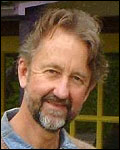Read Graham Caldersmith’s memoriam
Twenty-nine-year GAL member Graham Caldersmith started out studying reentry dynamics of spacecraft, but ended up studying the acoustic dynamics of guitars and violins. He lectured at the 1982 and 1998 GAL Conventions. Recently he has focused on developing a classical guitar family and refining the sound of violins made in Australian tonewoods.
▪ bio current as of 2017

